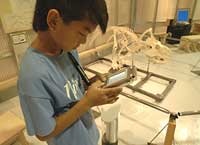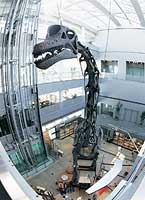SHOW ME
Consumers Enjoy the Latest Technology in Showrooms (March 1, 2004)
|
|
| Visitors use a PDA to learn about the exhibits. (Panasonic Digital Network Museum, Hayashibara Museum of Natural Sciences "Dinosaur FACTory") |
 |
The traditional image of showrooms is of places where major
corporations show off their latest wares, get consumers to test new products,
and stimulate people's desire to buy. Recently, however, showrooms have evolved
into places that entire families visit on holidays and where couples might even
go on a date. Many corporations nowadays are working to develop theme-park-like
showrooms where visitors can experience cutting-edge technology and learn about
new products while having an enjoyable time.
Stepping Back in Time
One attraction that has been especially well-received is the "Dinosaur Factory"
that has been set up in Tokyo's famous Panasonic Center, which features the technology
of the Matsushita Group. Visitors can step back in time as they witness the process
of research on dinosaur fossils conducted at the Hayashibara Museums of Natural
Sciences in Okayama Prefecture and even see a lifelike replica of a dinosaur as
well as a real specimen. At the entrance, visitors are given a personal digital
assistant (PDA), which they wear around their necks. When they reach different
areas of the exhibit and hold up the PDA to a pole called a Fact Scope, information
about nearby exhibits is displayed on the PDA. Visitors can also listen to an
audio program via earphones; the virtual tour guides are real researchers. The
visitors can also use the PDA to take pictures. Providing visitors with information
using PDAs is many times more efficient than having them read printed brochures
or signs at the exhibits; they can get the feeling that they are actually at a
dinosaur excavation site. A limited number of PDAs capable of presenting the information
in English is also available. Visitors wishing to use one should call ahead and
inquire about their availability.
|
|
| A real dinosaur skeleton (Panasonic Digital Network Museum, Hayashibara Museum of Natural Sciences "Dinosaur FACTory") |
 |
When visitors complete their tour, they are given a special
ID number and a password. After returning home, they can access the official
website [http://dinosaurfactory.jp/en/index.htm] and view the data from the
PDA they used during the tour, as well as any pictures they took.
Hands-on Experience
Tokyo's Odaiba district is home to the Toyota theme park called Mega Web, where,
in addition to seeing classic automobiles and mini cars, visitors can take new
models for a test drive on a limited course. Reservations are needed and can be
made by phone; English-speaking receptionists are available. In order to drive
one of the vehicles, it is necessary to have a drivers license from France, Germany,
or Switzerland, or an international license. Visitors who do not possess the necessary
license can still enjoy a ride in a small electric vehicle that drives itself,
which is a great way to move between pavilions. People intending to visit are
advised to check the English
version of the website [http://www.megaweb.gr.jp/English/index.html] ahead
of time so that they will understand the process.
Sekisui House, Ltd., reopened a newly renovated theme-park-like display of residential
facilities in Ibaraki Prefecture in October 2003, called Kanto Living Dream Factory.
Visitors can learn what makes a house an easy target for burglary and what steps
to take to prevent it. Natural disasters, such as the 1995 Hanshin-Awaji Great
Earthquake that rocked Kobe, are re-created, and visitors can experience the shaking
that such a temblor causes. Members of the factory's technical staff serve as
tour guides, but tours are unfortunately offered only in Japanese. While it would
be preferable to bring along someone capable of providing interpretation, no words
are necessary to experience the terror of an earthquake.
 Page Top Page Top
Related Web Sites
Dinosaur Factory
Panasonic Center
Copyright (c) 2004 Web Japan. Edited by Japan Echo Inc. based on domestic Japanese news sources. Articles presented here are offered for reference purposes and do not necessarily represent the policy or views of the Japanese Government.
|
 |

CHEAP THRILLS
(November 18, 2003)
EAT UP!
(February 17, 2003) |




